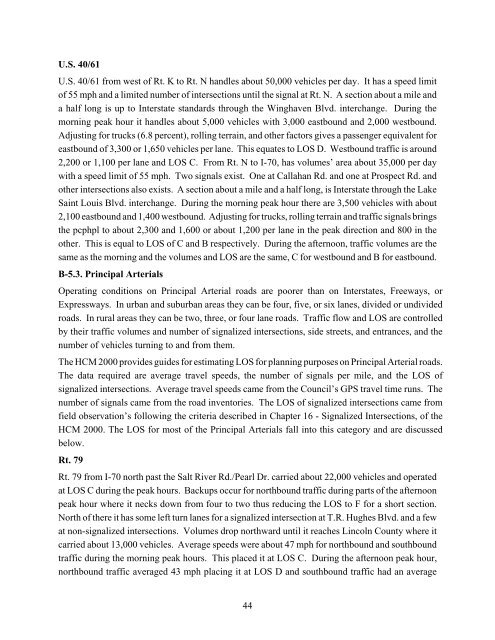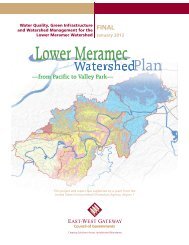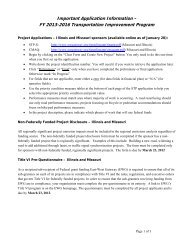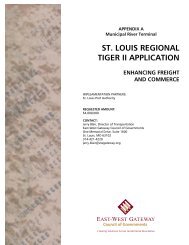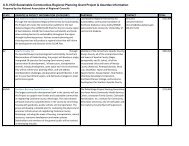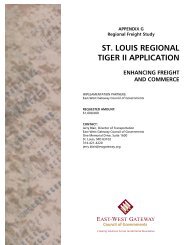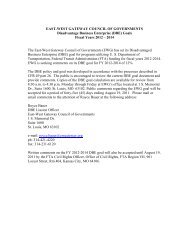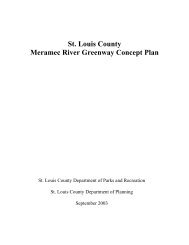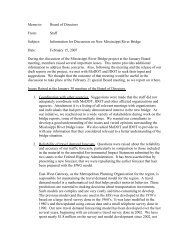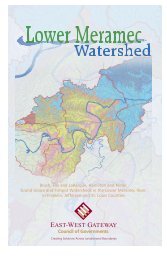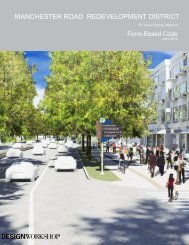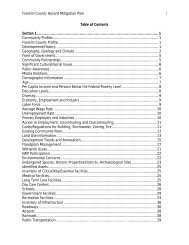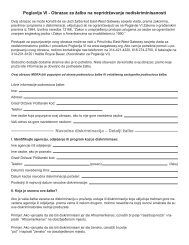St. Charles County Transportation Plan 2030 - East-West Gateway ...
St. Charles County Transportation Plan 2030 - East-West Gateway ...
St. Charles County Transportation Plan 2030 - East-West Gateway ...
You also want an ePaper? Increase the reach of your titles
YUMPU automatically turns print PDFs into web optimized ePapers that Google loves.
U.S. 40/61<br />
U.S. 40/61 from west of Rt. K to Rt. N handles about 50,000 vehicles per day. It has a speed limit<br />
of 55 mph and a limited number of intersections until the signal at Rt. N. A section about a mile and<br />
a half long is up to Interstate standards through the Winghaven Blvd. interchange. During the<br />
morning peak hour it handles about 5,000 vehicles with 3,000 eastbound and 2,000 westbound.<br />
Adjusting for trucks (6.8 percent), rolling terrain, and other factors gives a passenger equivalent for<br />
eastbound of 3,300 or 1,650 vehicles per lane. This equates to LOS D. <strong>West</strong>bound traffic is around<br />
2,200 or 1,100 per lane and LOS C. From Rt. N to I-70, has volumes’ area about 35,000 per day<br />
with a speed limit of 55 mph. Two signals exist. One at Callahan Rd. and one at Prospect Rd. and<br />
other intersections also exists. A section about a mile and a half long, is Interstate through the Lake<br />
Saint Louis Blvd. interchange. During the morning peak hour there are 3,500 vehicles with about<br />
2,100 eastbound and 1,400 westbound. Adjusting for trucks, rolling terrain and traffic signals brings<br />
the pcphpl to about 2,300 and 1,600 or about 1,200 per lane in the peak direction and 800 in the<br />
other. This is equal to LOS of C and B respectively. During the afternoon, traffic volumes are the<br />
same as the morning and the volumes and LOS are the same, C for westbound and B for eastbound.<br />
B-5.3. Principal Arterials<br />
Operating conditions on Principal Arterial roads are poorer than on Interstates, Freeways, or<br />
Expressways. In urban and suburban areas they can be four, five, or six lanes, divided or undivided<br />
roads. In rural areas they can be two, three, or four lane roads. Traffic flow and LOS are controlled<br />
by their traffic volumes and number of signalized intersections, side streets, and entrances, and the<br />
number of vehicles turning to and from them.<br />
The HCM 2000 provides guides for estimating LOS for planning purposes on Principal Arterial roads.<br />
The data required are average travel speeds, the number of signals per mile, and the LOS of<br />
signalized intersections. Average travel speeds came from the Council’s GPS travel time runs. The<br />
number of signals came from the road inventories. The LOS of signalized intersections came from<br />
field observation’s following the criteria described in Chapter 16 - Signalized Intersections, of the<br />
HCM 2000. The LOS for most of the Principal Arterials fall into this category and are discussed<br />
below.<br />
Rt. 79<br />
Rt. 79 from I-70 north past the Salt River Rd./Pearl Dr. carried about 22,000 vehicles and operated<br />
at LOS C during the peak hours. Backups occur for northbound traffic during parts of the afternoon<br />
peak hour where it necks down from four to two thus reducing the LOS to F for a short section.<br />
North of there it has some left turn lanes for a signalized intersection at T.R. Hughes Blvd. and a few<br />
at non-signalized intersections. Volumes drop northward until it reaches Lincoln <strong>County</strong> where it<br />
carried about 13,000 vehicles. Average speeds were about 47 mph for northbound and southbound<br />
traffic during the morning peak hours. This placed it at LOS C. During the afternoon peak hour,<br />
northbound traffic averaged 43 mph placing it at LOS D and southbound traffic had an average<br />
44


